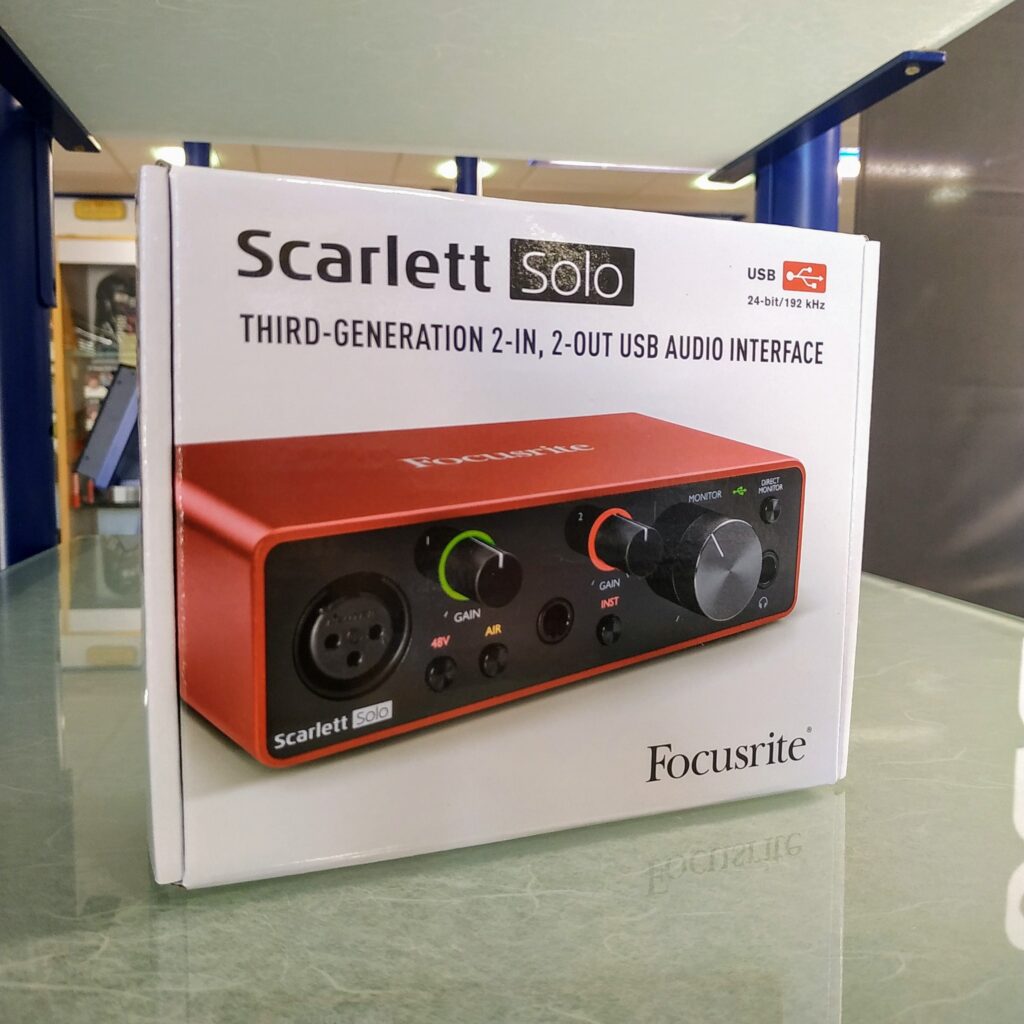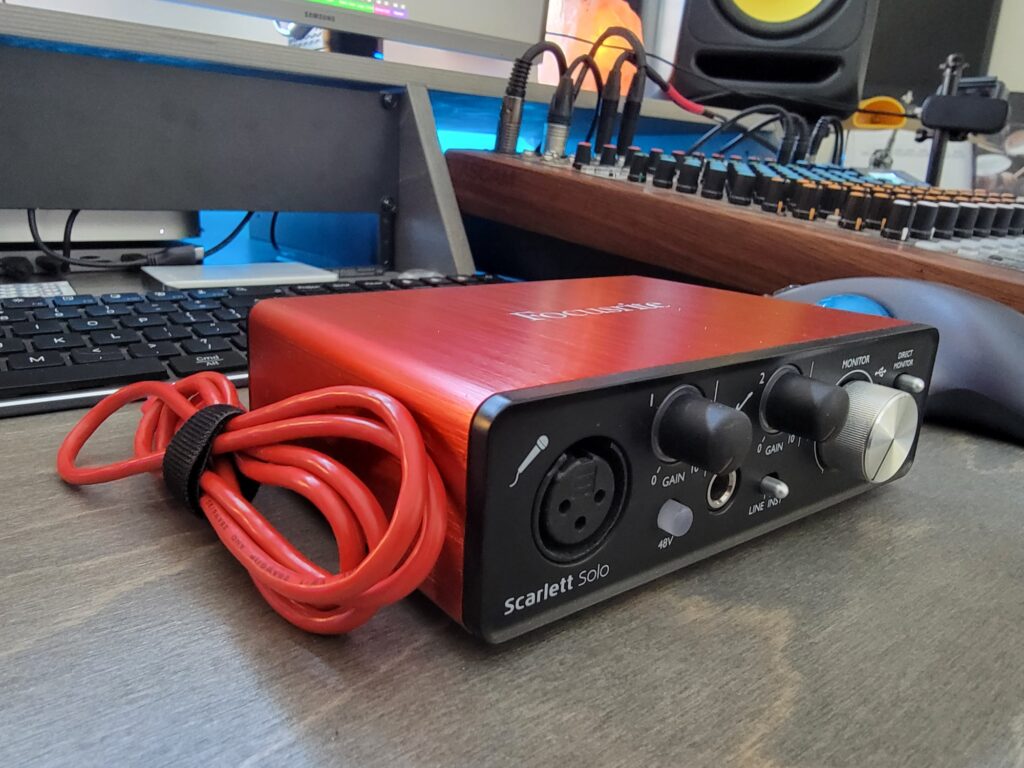Table of Contents
When it comes to simple home recording solutions, a USB audio interface is one of the most straightforward options. Because of the simplicity of the solution they provide, the market for bus-powered plug and play interfaces is rather saturated. With so many goods on the market, all of which are reasonably priced, it might be difficult to select the ideal piece of equipment for you.
Focusrite Scarlett Solo 3rd Gen Vs 2nd Gen: Comparison Chart
| Audio Interface | Focusrite 3rd gen | 2nd gen |
| Input | 1 XLR input with Phantom power and Air, 1 TRS line | 1 XLR input with phantom power, TRS line |
| Sample Rate | 192Khz | 192Khz |
| Separate Headphone Volume | No | Yes |
| Bundled software | Scarlett Plug-in Suite, Red 2, Red 3 Plugin Suite, Softube Time and Tone bundle, Focusrite Creative Pack, XLN Audio Addictive Keys, 3-month Splice Sounds subscription | Ableton Live Lite, Pro Tools First, Eleven Lite, Eleven MK2 Amp sim, 11 stompbox effects, Red 2 and Red 3 Plugin suites, and the Softube Time and Tone bundle are all included. |
| Power | Bus-Power Only | Bus-Power and Mains |
MUST-READ| Presonus Audiobox 96 Vs iTwo: A Comprehensive Comparison
Focusrite Scarlett Solo 3rd Gen Vs 2nd Gen: Detailed Analysis
Design-

This innovative gadget combines years of recording experience and tone in a box no larger or more expensive than an effect pedal.
Scarlett Solo, despite her petite stature, is a complete professional. The device’s red anodized finish is largely owned by Focusrite, and it simply exudes excellence. Everything you’ll ever need is right there on the front panel once you connect it to your computer via USB and run balanced wires (an upgrade from the 2nd Gen’s RCA jacks). Both of them looks same where 3rd gen have some minor tweaks in terms of design and ports, The top panel The Scarlett series’ first air switch is intended to bring the preamp even closer to the wonderfully beguiling sound and mood of Focusrite’s holy grail ISA mic pre. You also receive 48-volt phantom power, zero-latency direct monitoring, and a headphone jack. Everything is basic, clean, and elegant.
Input-
It has two combined instrument and mic inputs, dual headphone outputs, gain halos, S/PDIF I/Os, MIDI Input and Output, and four more line-level instrument inputs – 8-in 6-out makes this a fantastic audio interface for the hardware-based musician, 3rd generation features 4 mic inputs, 8 balanced line inputs, 4 balanced outputs, 2 high headroom instrument inputs, and 4 monitor outs enabling dual monitor speaker switching – yet another great option for band practise or the hardware-centric producer. Scarlett Solo’s 2nd generation inputs are located on the front panel; Input 1 has a standard 3-pin XLR socket and is configured to operate with most types of microphones; a matching XLR male connector can be found on the end of the supplied mic cable. Input 2 accepts higher level inputs from a guitar or bass through a 14″ (6.35 mm) jack socket (2-pole when in instrument mode and 3-pole when used as a line input).
MUST-READ| Behringer UMC404hd Vs Focusrite 4i4: Which Is Better?
Preamps-
Scarlett interfaces of the third generation are distinguished by strong gain and low noise. Making mic preamps 3rd version includes 4 mic inputs, 8 balanced line inputs, 4 balanced outputs, 2 high headroom instrument inputs, and 4 monitor outs for dual monitor speaker switching — yet another wonderful alternative for band practise or the hardware-centric producer. The third-generation Focusrite interfaces essentially have newer updated preamps and more headroom. When comparing 2nd gen to 3rd gen, you probably won’t notice a change in routine streaming/recording uses.
Latency
The Scarlett 3rd generation has extremely low latency and allows you to monitor in real-time with native plug-in effects. Simply turn the brand new ‘direct monitor’ circuit switch if you want to monitor your input directly with guaranteed low-latency. The Dynamic Range value for line, mic, and instrument inputs is roughly 110dB for the 3rd gen series, an improvement over the 2nd gen’s 106dB.
Software

The Focusrite Control programme allows you to configure key global device characteristics such as mixing and routing options, clock, and numerous inputs, as well as assignable functions for Air mode in both 2nd and 3rd generation units. The Focusrite Control software, like the Quick Start process, has been designed for ease of use. When compared to a number of other similarly priced brands, configuring your ideal routing is a piece of cake.
Focusrite performs an excellent job of combining their equipment with user-friendly, cutting-edge software. In addition, they provide a two-year guarantee and membership in the Focusrite Plug-In Collective, which provides regular free software downloads and substantial discounts.
Overall, purchasing a Scarlett Gen 3 device includes Ableton® Live LiteTM, Pro Tools® | First Focusrite Creative Pack, a free three-month Splice Sounds subscription, XLN Audio Addictive Keys, Focusrite Red Plug-in Suite, and Softube Time & Tone Bundle, whereas the majority of these packages were not available in the second generation.
MUST-READ| Blue Snowball Vs Blue Yeti USB Microphone: Review and Comparison!
Recording session
This is the section where the both of the Audio Interface moves and grooves both of them have almost similar interface and quality in terms of recording but 3rd gen having some advance tweaks takes the place of 2nd gen
The Scarlett CM25 MkII microphone, which comes with the Scarlett Solo Studio package, is a studio-quality condenser microphone that is perfect for recording vocals and most acoustic instruments.
To function, condenser microphones require a source of DC power. To work with the Scarlett Solo, push the 48V button on the front panel, Focusrite’s 3rd Gen mic preamp is the greatest Scarlett has ever developed. The 24-bit/192kHz converters improve the clarity of your recordings. Furthermore, its Air mode gives vocalists an extra edge and provides unique, high-end detail.
Setup
Installation is the same as with the Focusrite series—plug and play—but with Scarlett 3rd generation devices, this is about as close to plug-and-play as you can go with technology this advanced. Their new onboarding routine is dubbed the “Focusrite Quick Start” tool.
Connect the device to your computer, follow the installation directions in the pop-up window, and you’ll be automatically taken to a webpage for personalised installation.
Extra Feature-
The USB-C invasion continues. All Scarlett 3rd generation versions include a USB-C port. Simply connect your recording device of choice to your laptop with the included USB-C to USB-A connector whenever and whenever you wish to record. This connection update not only makes it more convenient, but it also increases device speeds and virtually eliminates latency.
MUST-READ| 12 Best Apps For Dog Owners You Should Definitely Have!
Focusrite Scarlett Solo 3rd Gen Vs 2nd Gen: Quick Result
| Audio Interface | Focusrite 2nd gen | Focusrite 3rd gen |
| Max Sample Rate | 192Khz | 192Khz |
| Pre-amp gain | 50dB | 56dB |
| Output | 10-16dBu | 5.5dBu |
| USB | USB 2.0 | USB C |
Focusrite Scarlett Solo 3rd Gen Vs 2nd Gen: Final Verdict
If you already own a first or second-generation Scarlett 2i2 or Solo interface and want to upgrade, the third-generation interfaces are a great choice.
If you like the Solo format, consider upgrading to Gen 3 for an upgraded appearance and feel, notably better sound quality, and a slew of additional enhancements and features.
If you already own a first or second-generation Scarlett 2i2 or Solo interface and want to upgrade, the third-generation interfaces are a great choice.
If you like the Solo format, consider upgrading to Gen 3 for an upgraded appearance and feel, notably better sound quality, and a slew of additional enhancements and features.
MUST-READ| 12 Best Apps For Cat Owners That You Should Know!





